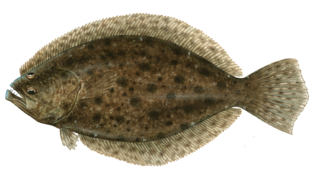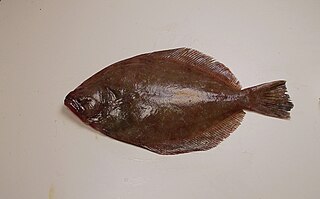Southern flounder: Difference between revisions
(Created page with "<div class="irlbody"> {{IRL header estuary|cat=Fish}} <div class="irlcontenttop" style="margin-top:1em"><!-- {{subst:#InterwikiExtract:Paralichthys lethostigma|format=text}} -...") |
mNo edit summary |
||
| Line 2: | Line 2: | ||
{{IRL header estuary|cat=Fish}} | {{IRL header estuary|cat=Fish}} | ||
<div class="irlcontenttop" style="margin-top:1em"><!-- {{subst:#InterwikiExtract:Paralichthys lethostigma|format=text}} --> | <div class="irlcontenttop" style="margin-top:1em"><!-- {{subst:#InterwikiExtract:Paralichthys lethostigma|format=text}} --> | ||
[[File: | [[File:Southern_flounder.png|alt=Southern flounder (Paralichthys lethostigma)|thumb|320px|Southern flounder (Paralichthys lethostigma)]] | ||
<p><i><b>Paralichthys lethostigma</b></i>, the <b>southern flounder</b>, is a species of large-tooth flounders native to the eastern and gulf coasts of the United States. It is a popular sports fish and is the largest and most commercially valuable flounder in the western North Atlantic Ocean and Gulf of Mexico. It is a "left-eyed flounder", meaning the left side is pigmented and is the "up side".</p> | <p><i><b>Paralichthys lethostigma</b></i>, the <b>southern flounder</b>, is a species of large-tooth flounders native to the eastern and gulf coasts of the United States. It is a popular sports fish and is the largest and most commercially valuable flounder in the western North Atlantic Ocean and Gulf of Mexico. It is a "left-eyed flounder", meaning the left side is pigmented and is the "up side".</p> | ||
| Line 17: | Line 15: | ||
<p>Juvenile southern flounder stay in estuaries, and most leave to spawn offshore during the fall and winter as adults. Young fish are eventually pushed into the estuaries by ocean currents to mature. Southern flounder reach sexual maturity around two years of age. Older, larger fish tend to begin the spawning migration earlier. Female fish both grow faster and live longer than males.</p><p>The annual growth cycle of the southern flounder starts in the spring and ends in the fall as the water temperature decreases. Males live for around 5 years, and females live for around 7–8 years.</p> | <p>Juvenile southern flounder stay in estuaries, and most leave to spawn offshore during the fall and winter as adults. Young fish are eventually pushed into the estuaries by ocean currents to mature. Southern flounder reach sexual maturity around two years of age. Older, larger fish tend to begin the spawning migration earlier. Female fish both grow faster and live longer than males.</p><p>The annual growth cycle of the southern flounder starts in the spring and ends in the fall as the water temperature decreases. Males live for around 5 years, and females live for around 7–8 years.</p> | ||
<h2><span id="Distribution">Distribution</span></h2> | <h2><span id="Distribution">Distribution</span></h2> | ||
[[File:Paralichthys_lethostigma.jpg|alt=Southern flounder (Paralichthys lethostigma)|thumb|320px|Southern flounder (Paralichthys lethostigma)]] | |||
<p>The southern flounder is distributed across the western north Atlantic Ocean and the Gulf of Mexico. This species is listed by the IUCN as near threatened due to both commercial and recreational overfishing, and mortality from the shrimp trawl industry. This species is also affected by habitat destruction from human causes.</p> | <p>The southern flounder is distributed across the western north Atlantic Ocean and the Gulf of Mexico. This species is listed by the IUCN as near threatened due to both commercial and recreational overfishing, and mortality from the shrimp trawl industry. This species is also affected by habitat destruction from human causes.</p> | ||
<h2><span id="Importance_to_humans">Importance to humans</span></h2> | <h2><span id="Importance_to_humans">Importance to humans</span></h2> | ||
| Line 25: | Line 24: | ||
<h2><span id="Etymology">Etymology</span></h2> | <h2><span id="Etymology">Etymology</span></h2> | ||
<p>The genus name, <i>Paralichthys</i>, is usually interpreted as "parallel fish" in reference to the deeply compressed body shape. However, some interpret it as "close to the sea", from the Greek word, <i>para</i>, meaning beside or near. This can be in reference to the way it buries itself in the sand and lies flat as if it is a part of the sea floor itself. The species name, <i>lethostigma</i>, comes from the Latin word, <i>letho</i>, meaning death, and the Greek word, <i>stigma</i>, meaning spots. The meaning "forgotten spots" or "death of spots" refers to the absences of conspicuous large occellaed spots that is common in other species of flatfish.</p> | <p>The genus name, <i>Paralichthys</i>, is usually interpreted as "parallel fish" in reference to the deeply compressed body shape. However, some interpret it as "close to the sea", from the Greek word, <i>para</i>, meaning beside or near. This can be in reference to the way it buries itself in the sand and lies flat as if it is a part of the sea floor itself. The species name, <i>lethostigma</i>, comes from the Latin word, <i>letho</i>, meaning death, and the Greek word, <i>stigma</i>, meaning spots. The meaning "forgotten spots" or "death of spots" refers to the absences of conspicuous large occellaed spots that is common in other species of flatfish.</p> | ||
</div> | </div> | ||
<div class="irlcontentbottom noprint"> | <div class="irlcontentbottom noprint"> | ||
Revision as of 16:39, November 13, 2021
Paralichthys lethostigma, the southern flounder, is a species of large-tooth flounders native to the eastern and gulf coasts of the United States. It is a popular sports fish and is the largest and most commercially valuable flounder in the western North Atlantic Ocean and Gulf of Mexico. It is a "left-eyed flounder", meaning the left side is pigmented and is the "up side".
Description
The body color is brown with diffuse, unocellated spots and blotches. This species typically grows to around 12-14 inches in length.
Diet
Larval and postlarval southern flounder feed on zooplankton. As juveniles, the southern flounder's diet consists of small invertebrates, and shifts to larger invertebrates and fish as they reach adult size. Southern flounder feed on the bottom of the ocean and in the water column, and are considered to be near top predators.
Habitat
Adult fish breed and spend the warmer season in coastal embayments and nearshore shelf waters, where the eggs develop until they are late stage larvae, which are then pushed by currents into the estuaries where the fish settle into the sediment and grow into juveniles. The juveniles stay in the estuaries until they reach sexual maturity and leave to spawn.
The southern flounder can survive in lower salinities and have even been found to use freshwater habitats both as juveniles and as adults.
Reproduction and life cycle
Juvenile southern flounder stay in estuaries, and most leave to spawn offshore during the fall and winter as adults. Young fish are eventually pushed into the estuaries by ocean currents to mature. Southern flounder reach sexual maturity around two years of age. Older, larger fish tend to begin the spawning migration earlier. Female fish both grow faster and live longer than males.
The annual growth cycle of the southern flounder starts in the spring and ends in the fall as the water temperature decreases. Males live for around 5 years, and females live for around 7–8 years.
Distribution
The southern flounder is distributed across the western north Atlantic Ocean and the Gulf of Mexico. This species is listed by the IUCN as near threatened due to both commercial and recreational overfishing, and mortality from the shrimp trawl industry. This species is also affected by habitat destruction from human causes.
Importance to humans
Southern flounders are a major and valuable species in the highly important commercial and recreational flounder fishery in the Gulf of Mexico. Most of the commercial catch in the Gulf of Mexico is incidental to the catch by shrimp trawlers. Recreationally, they can easily be caught by anglers on a line with either a lure or live bait. Another popular form of collecting flounders is by night gigging. In this sport, anglers use a gig, or a multi-pronged spear, to impale the fish after using a flashlight to spot it in the waters at night.
Southern flounder are also considered valuable as an aquaculture species because of their ability to live in water of varying salinities. Research has been conducted on using soy based protein sources rather than fish meal to grow the fish to reduce environmental impact.
Etymology
The genus name, Paralichthys, is usually interpreted as "parallel fish" in reference to the deeply compressed body shape. However, some interpret it as "close to the sea", from the Greek word, para, meaning beside or near. This can be in reference to the way it buries itself in the sand and lies flat as if it is a part of the sea floor itself. The species name, lethostigma, comes from the Latin word, letho, meaning death, and the Greek word, stigma, meaning spots. The meaning "forgotten spots" or "death of spots" refers to the absences of conspicuous large occellaed spots that is common in other species of flatfish.


